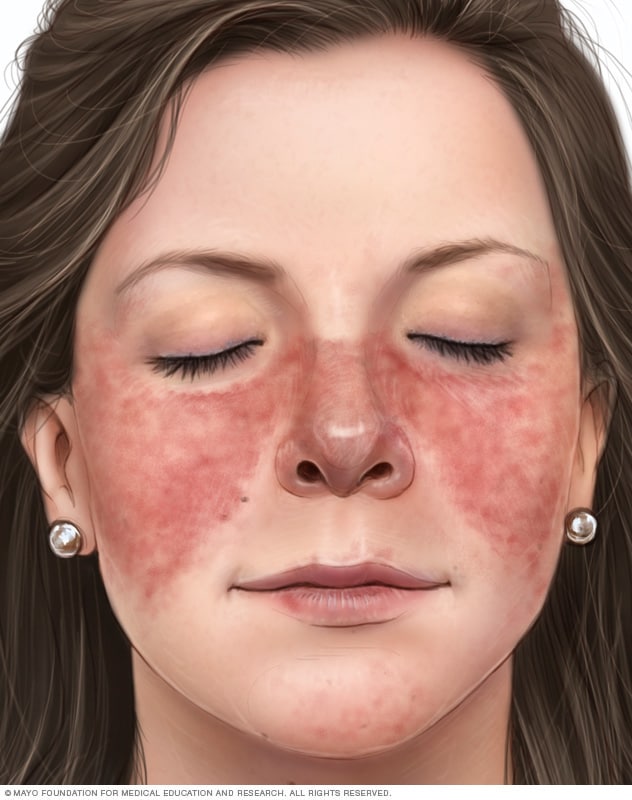Lupus is a systemic autoimmune disease that occurs when your body’s immune system attacks your own tissues and organs. Inflammation caused by lupus can affect many different body systems — including your joints, skin, kidneys, blood cells, brain, heart and lungs.
Lupus can be difficult to diagnose because its signs and symptoms often mimic those of other ailments. The most distinctive sign of lupus — a facial rash that resembles the wings of a butterfly unfolding across both cheeks — occurs in many but not all cases of lupus.
Some people are born with a tendency toward developing lupus, which may be triggered by infections, certain drugs or even sunlight. While there’s no cure for lupus, treatments can help control symptoms.
No two cases of lupus are exactly alike. Signs and symptoms may come on suddenly or develop slowly, may be mild or severe, and may be temporary or permanent. Most people with lupus have mild disease characterized by episodes — called flares — when signs and symptoms get worse for a while, then improve or even disappear completely for a time.
If you follow Hollywood pop culture you probably heard the news of Selena Gomez having Lupus. Most of us who heard the news heard of the condition for the first time. But although not very common, it is not a disease you would want to take lightly. Lupus is an autoimmune disease, where the immune system starts attacking the body’s own tissue. The immune system cannot differentiate between self and foreign particles and damages the system. While there is no cure for it, early identification can help in getting timely treatment to control the disease. Lupus can be managed through proper treatment. About one in 2000 people get affected by Lupus. The disease is five times more likely to be found affecting women than men. To help you stay ahead of the disease, here are a few symptoms of Lupus in women that should never be ignored.
The signs and symptoms of lupus that you experience will depend on which body systems are affected by the disease. The most common signs and symptoms include:
- Fatigue
- Fever
- Joint pain, stiffness, and swelling
- Butterfly-shaped rash on the face that covers the cheeks and bridge of the nose or rashes elsewhere on the body
- Skin lesions that appear or worsen with sun exposure (photosensitivity)
- Fingers and toes that turn white or blue when exposed to cold or during stressful periods (Raynaud’s phenomenon)
- Shortness of breath
- Chest pain
- Dry eyes
- Headaches, confusion and memory loss

Butterfly Rash on the Face
One of the most commonly visible symptoms of Lupus is the appearance of a rash across the cheeks and the bridge of the nose. Autoimmune diseases are those in which the immune system fails to recognize the difference between self and foreign cells. Thus, it starts attacking the body’s own cells and results in damage to the body. When the body is affected by the condition called Systemic Lupus Erythematosus (SLE) or Lupus, it can start attacking the skin tissues too. To compensate for this loss of skin tissue the body rapidly generates more skin cells. This rapid production of skin cells combined with exposure to the UV rays of sunlight results in the development of the Butterfly Rash on the face. You might also notice other skin imperfections if you are suffering from Lupus. These include sensitivity to the sun that leads to the development of flaky, red spots or a scaly, purple rash. These can appear on various parts of the body like neck, arms and of course, the face. Although rare, some people also develop mouth sores if affected by Lupus.
Joint Pains
Lupus Arthritis is the medical term for the joint pains, swelling, stiffness, and tenderness during Lupus. At first experience, this might feel similar to Rheumatoid Arthritis. However, there are a few differences between the two that can help you differentiate. First of all, these joint pains will be felt in joints farthest from the middle of the body. These are the joints in your fingers, wrists, elbows, knees, ankles, and toes. Second, similar joints on both sides of the body are affected. The pain might be felt in the morning and then subside during the day. But the chances of it returning later in the day are not unlikely. Lupus arthritis, however, is less disabling and less damaging for the joints.
Muscle and Tendon Aches
Lupus is an inflammatory disease. This becomes one of the main reasons for muscle pains. Inflammation will be accompanied by fevers, sweats, chills, loss of appetite, etc. However, inflammation can be a symptom of many other diseases and disorders, as it occurs whenever the body is overwhelmed by an unusual change. Lupus myositis is another condition developed during Lupus that leads to muscle aches. Lupus myositis affects the muscles in the neck, pelvis, thighs, shoulders and upper arms, due to inflammation of the skeletal muscles. This leads to a condition wherein the initial stages, the affected person has difficulty getting up from a sitting position, climbing stairs, etc. If Lupus is not treated then advanced stages of Lupus myositis leads to even further difficulty in lifting the arm to comb the hair, lifting heavy objects to an elevated place, and even turning in bed becomes a problem.
Kidney Problems
The inflammatory symptom of Lupus can sometimes affect the kidneys too. Most patients suffer from kidney problems when affected by Lupus. So, the doctors divide cases into those with and those without problems of the kidney. Lupus Nephritis is the medical name of the disorder. Due to inflammation of the nephrons in the kidney, they are unable to filter the blood of impurities. This leads to a build-up of waste in the bloodstream that will show as swelling in the body. In fact, weight gain and swelling in the feet, ankles, legs, hands, or eyelids, is one of the first signs of Lupus nephritis. Problems in the kidneys develop in the first five years of Lupus. Other symptoms of this include, elevated blood pressure, blood in the urine, increased urination especially at night time, and foamy appearance of the urine.
Shortness of Breath and Chest Pains
Persons affected by Lupus can also develop problems of the respiratory system. Aa sharp, stabbing pain felt in the chest can be caused by inflammation of the pleura, the lining that covers the outside of the lungs. The pain is made worse when you take a deep breath, sneeze, laugh or a cough. Pneumonitis is the condition where inflammation reaches the lung tissue. The symptoms of pneumonitis include chest pains, fever, shortness of breath, and cough. Chronic inflammation can lead to scarring of the lung tissues which makes it difficult for the oxygen to move from the lungs to the blood. This condition is accompanied by symptoms like chest pain, chronic dry cough, and difficulty breathing during physical activity.
Chronic Fatigue
Chronic fatigue is a symptom of 50% of all the diseases in the world. On its own, it might not mean a thing. Yet, when accompanied by other signs of Lupus, it is not a symptom you would want to ignore. With your immune system in chaos, it is no wonder that the excessive work your body has to do to make up for the lost tissue will have its toll on the body. Fatigue caused by Lupus is no regular lack of energy either. This is not being able to get out of the bed in the morning kind of fatigue. The widespread muscle pain due to Lupus also causes this kind of fatigue. If your Lupus has been identified, then you can use the following tips to help cope with the fatigue. Get regular exercise no matter how little you exert the body. Just enough to give your body some edge over the fatigue. Get enough rest and don’t overwork yourself. Prioritize your work and don’t waste your energy on wasteful activities.
Mental Health Concerns
Mental health gets affected severely in 20-60% of cases of Lupus. Some of the effects of Lupus affecting the brain include hallucinations, seizures, depression, paranoia, confusion, etc. Many patients complain of not being able to concentrate well enough. The pain plays a role in this in part. When the body is suffering through a lot of pain it becomes difficult to remember or memorize things. Fatigue can also play a role in disturbing mental health. But advanced stages of Lupus do affect the cognitive functions of the brain. Symptoms of Lupus affecting the cognitive functions of the brain include poor memory, trouble concentrating, inability to multitask, difficulty finding the right word, slow processing, and poor executive function abilities. If you find these symptoms affecting your mental health, consult your doctor as soon as possible.
Lupus cannot be cured but it can be controlled. Women in their child-bearing years are more susceptible to developing Lupus. Thus, it is important that we take good care of our health. If, however, you find yourself suffering these symptoms, see a doctor immediately. The sooner you start getting treatment the easier it will be to cope with the problem.
Follow us across our social channels to get the latest, Facebook , Twitter .








